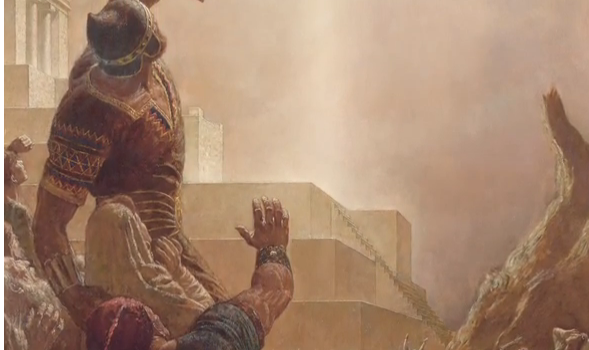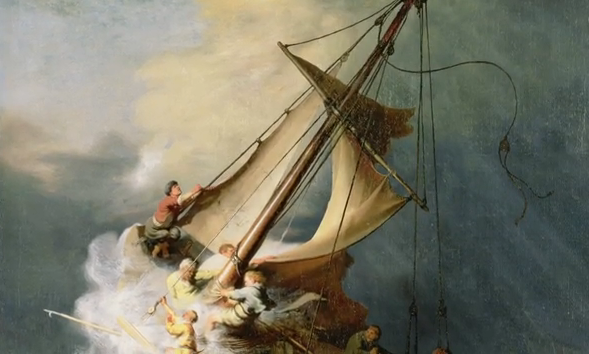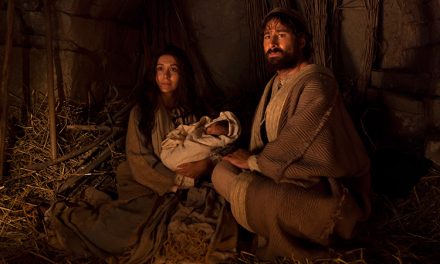Who is this ancient figure who stands at the crossroads of history? Is He a great teacher? A revolutionary? Prophet? Or is He, indeed, the divine Son of a divine Father? The literal Savior of the world? In struggling to answer this question, many scholars dismiss the divine and separate the Jesus of history, the mortal man, from the Jesus of faith, the Son of God. Today, Latter-day Saint scholars seek to join history and faith, scholarship and modern revelation, to reach a more complete understanding of who Jesus was and is.
He has been called a peasant, a mystic, a charismatic leader, a wise teacher, an influential social critic. His words have been pored over, adapted, and translated into nearly every language. Tales of his many miracles have been celebrated by even the obscurest of cultures. The story and life of Jesus Christ, however, began long before Bethlehem. By studying the biblical record, together with the Book of Mormon and modern revelation, we are able to paint a more complete picture of this Jesus of Nazareth. To answer the ancient question, “Who is this man?” we must journey back to a beginning before the beginning: To the Premortal Realm.
ANDREW C. SKINNER: It is surprising, given the fact that the New Testament speaks so profoundly of the concept of a premortal existence, that more Christians don’t talk about a premortal existence in the world today. We know for example that there are both biblical and nonbiblical or extrabiblical sources—sources outside the New Testament canon—that speak generally about the principle or the concept of a premortal existence. But there are these exceptional sources that not only talk about the general concept of a premortal existence, but also zero in on the premortal existence of Jesus Christ. And these references date from either before the time of Jesus, or during this intertestamental period when Jesus performed his ministry here on the earth.
 CECILIA M. PEEK: There is surviving in so-called patristic literature, and even later, references to Christ as the God who visited Abraham, for example, and as the God of the Old Testament. You find references in Justin, in Irenaeus. One of the most famous is quite a late one. It’s a 5th century author in his ecclesiastical history, by the name of Sozeman, who refers to a church—actually a site, on which a church was built by Constantine—Mamre is the location. And Sozeman tells us that this was a place where there was a great market and great events celebrated, that both Jews and—pagans—is actually the term that Sozeman used—and Christians all considered this a central location. And he said Christians considered it a central location because it was on this site that “he who would be born of a virgin appeared to that pious man”—meaning Abraham. So it’s a very explicit reference to their belief that Christ was in fact the God who visited Abraham.
CECILIA M. PEEK: There is surviving in so-called patristic literature, and even later, references to Christ as the God who visited Abraham, for example, and as the God of the Old Testament. You find references in Justin, in Irenaeus. One of the most famous is quite a late one. It’s a 5th century author in his ecclesiastical history, by the name of Sozeman, who refers to a church—actually a site, on which a church was built by Constantine—Mamre is the location. And Sozeman tells us that this was a place where there was a great market and great events celebrated, that both Jews and—pagans—is actually the term that Sozeman used—and Christians all considered this a central location. And he said Christians considered it a central location because it was on this site that “he who would be born of a virgin appeared to that pious man”—meaning Abraham. So it’s a very explicit reference to their belief that Christ was in fact the God who visited Abraham.
ERIC D. HUNTSMAN: The prologue to the gospel of John, verses 1–18 of chapter 1, is often referred to as the Logos Hymn—a hymn because it is different in style and structure than much of the rest of the text. It’s actually laid out in parallel couplets, almost as if it were a Hebrew poem, even though it was written in Greek. But perhaps more important than the form of the document is its context.
CECILIA M. PEEK: En archê ên o logos kai o logos ên pros ton theon kai theos ên o logos: In the beginning was the Word, and the Word was with God, and the Word was God. If you were to look up the word logos in the large Greek lexicon that every tortured classics major has to deal with in their life, you would find, you know, six columns of single-spaced writing on this one word. It, you know, it can mean account, it can mean discussion, it can mean debate, it can mean logic, it can mean reason, it can mean intelligence. It’s one of the richest words, and surely John chose it because of that richness.
ERIC D. HUNTSMAN: We call it the Logos Hymn because of the Greek term logos, which, conventionally translated “the word,” is in our King James versions of the Bible. But the word logos had a very broad semantic range in classical and biblical Greek. Logos, according to Plato and some of the early Greek philosophers, is what distinguished us from the animals. Not that animals didn’t feel and could not communicate in some way, but logos was the means by which thoughts and ideas were communicated from one person to another. So it can mean “word,” but it can also mean “thought,” or “idea,” “reason,” “cause,” etc. I communicate with another person, my thoughts are turned into words, and the words go to that person and turn into thoughts in his head. So a logos is something that can affect something.
CECILIA M. PEEK: In the Doctrine and Covenants, we have very similar terms used to those used by John to describe Christ. And in fact it is the testimony of John that is articulated there. And I’ll read just a short selection from that. This is the 93rd section of the Doctrine and Covenants. Beginning in verse 6 it says, “And John saw and bore record of the fullness of my glory. And the fullness of John’s record is hereafter to be revealed. And he”—that is, John—“bore record saying, I saw his glory, that he was in the beginning, before the world was. Therefore, in the beginning the Word was, for he was the Word, even the messenger of salvation, the light and the Redeemer of the world, the spirit of truth, who came into the world because the world was made by him. And in him was the life of men and the light of men.” So what John tells us is confirmed and expanded in this revelation in latter-day scripture.
ERIC D. HUNTSMAN: It is saying essentially that God existed, and that God began to interact or communicate with something broader through the means of this Logos, which of course we come to understand as His Only Begotten Son. It also has lots of interesting resonances with the book of Genesis, because Genesis opens with its creation account saying, “In the beginning, God said, Let there be light.” It was the act of saying that caused light to come into being. And so an astute reader would make that connection, would sense that resonance with that expression “the Word” in the Greek of John 1:1, and, of course, either in the Greek translation of Genesis or in its original Hebrew, they would have that sense of logos.
RICHARD HOLZAPFEL: There’s another interesting passage also in the book of Hebrews. In this passage, in chapter 1, the author says that in previous times and in various ways God spoke to Israel, spoke to his people through the prophets. And then he makes a startling analogy: “But in this day he has spoken to us through his Son Jesus Christ, by whom he created the worlds.” Some translations say universe, such as the NIV; others say other terms, but the idea is that Jesus, whom God’s voice is now heard through, in the day in which this letter was written, the dispensation in which Jesus came, is that same Jesus who was the Creator of the worlds, or universe.
JOHN S. TANNER: The Sea of Galilee. Oh how I love coming here. Galilee. Even the very name recalls a host of stories from the New Testament that I love—of Jesus walking along the shore and calling out to fishermen casting their nets into the sea, “Come, follow me,” of nets bursting with a miraculous catch. And one of the stories I most love must have occurred on a day like this, a stormy day when a sudden storm came up violently, as they often do from the west over there in Tiberius. And Jesus, standing up on the boat in the stern of that boat, in the midst of this tempest, rebuked the wind. And He said unto the sea, “Peace, be still. And the wind ceased, and there was a great calm” (Mark 4:39).
Now Mark records an interesting reaction of the disciples when this happens. He said, “They feared exceedingly, and said one to another, What manner of man is this, that even the wind and the sea obey him?” (Mark 4:40). The disciples had been with Jesus for months, and had seen him perform many miracles—healing the sick, causing the blind to see, and even raising a man from the dead—yet they feared exceedingly when they saw that this man that they’d left their nets to follow had power over the very elements. Eventually they’d come to understand that the elements and all creation obey Jesus, believe He himself is the very Lord of Creation.
CAMILLE FRONK OLSON: In Colossians chapter 1, begins probably in verse 12, and goes through verse 19, speaking of Jesus Christ, who “is in the image of the invisible God, the firstborn of every creature,” or in other words, in the Greek, even “the firstborn of all creation,” telling us that the Christians must have understood that Christ was the Creator, the firstborn, born, created before anything else was created. And also in verse 17, “he is before all things, and by [him] all things consist.” Verse 16, the one in between, even talks about him being the Creator: “by him were all things created that are in heaven and that are in earth, visible and invisible.” I think that’s a really crucial phrase, that “visible or invisible,” suggesting that there is far more that Christ created than we even recognize and have seen.
RICHARD D. DRAPER: The Greek is ta orata kai ta aorata. I would translate it “the seen and the unseen.” What Paul is doing is coming out of the worldview in his own age, in which there were—the world could be divided into two pieces. One piece was the seen, okay, those objects and thing that we can see. But there was another part of this world just as real, but it was forces, forces that shaped and moved history, that were invisible or unseen by us. He calls these the thrones, principalities, dominions, okay, these kind of powers. And what the prophet is saying to us is that Jesus was not subject to these unseen influences or powers, because He actually is the Creator of all things.
MICHAEL D. RHODES: In Moses chapter 7, for example, as Enoch looks at the history of the world unfold, he sees the crucifixion of Christ. He says, “All the creations of God moaned, and the earth groaned, and the rocks were rent” (Moses 7:56). So it’s not even just this earth, it is the very creations that Jesus Christ had made as agent of His Father in Heaven, cried out in agony as their Creator suffered there the atoning sacrifice.
PAUL Y. HOSKISSON: The Book of Mormon clearly, I think, teaches us that the concept of Jesus Christ as the Creator of this world and other worlds, existed before the time of Christ. When we look at a passage here in Mosiah, chapter 3 verse 8, which are the words of an angel given to King Benjamin, it says: “And he [the Savior]shall be called Jesus Christ, the Son of God, the Father of heaven and earth, the Creator of all things from the beginning, and his mother shall be called Mary.” It’s clear here that not just the angel but, I suspect, all the people in the Book of Mormon realized that the God of the Old Testament, whom we believe is Jesus Christ, was the Creator of this earth and all that exists in it.








